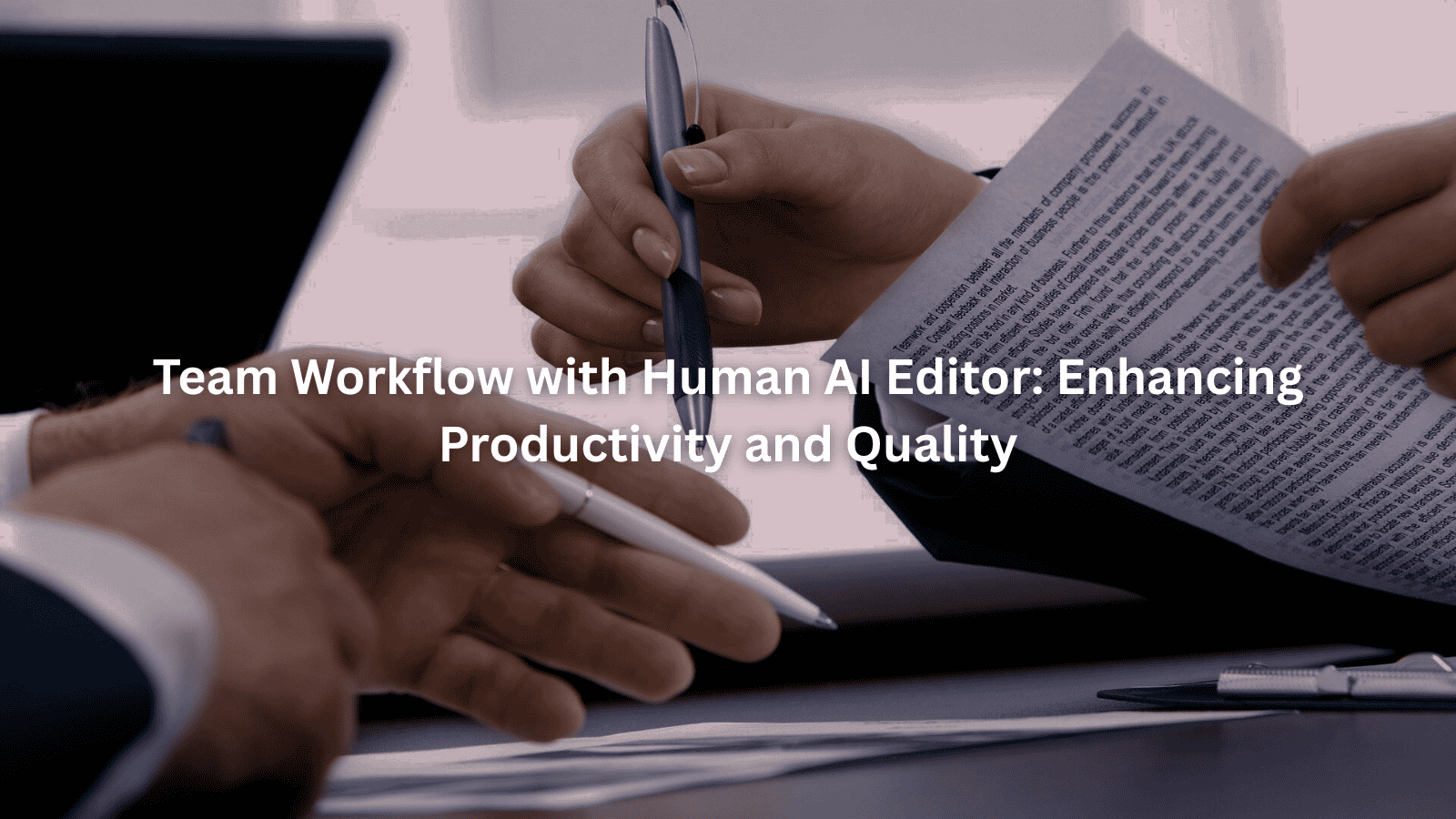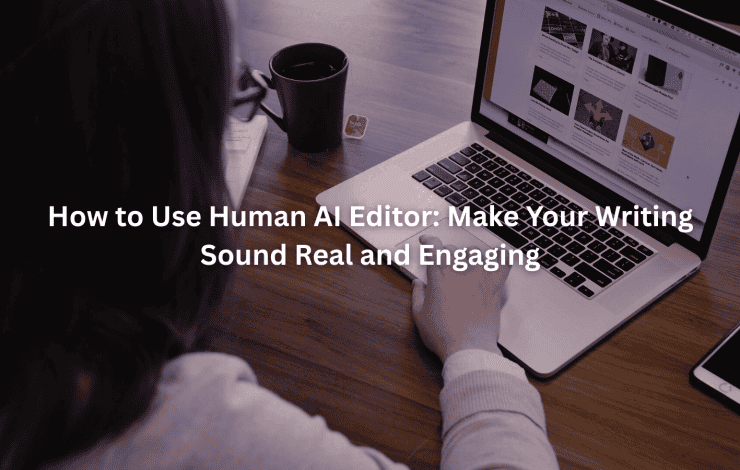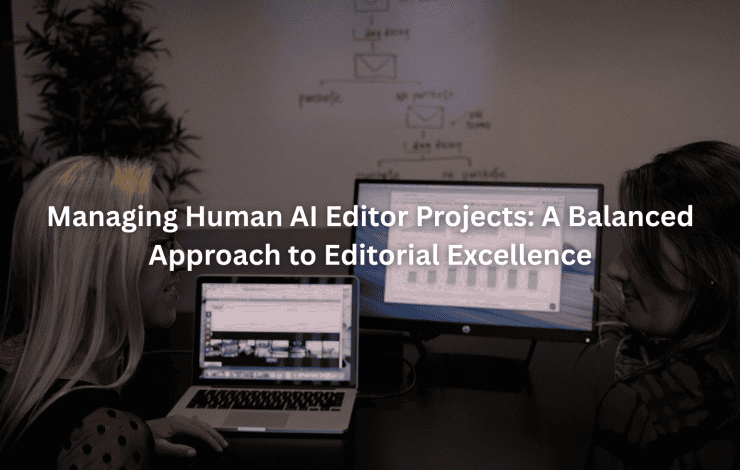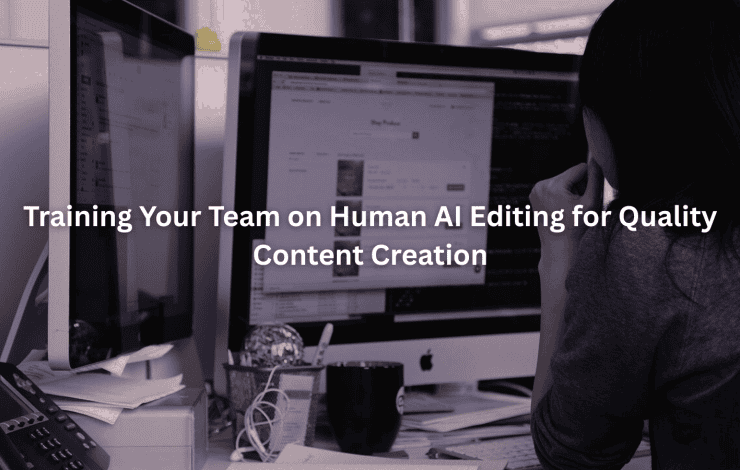Look, We figured something out at Jet Digital Pro. Nothing fancy really. They let their computers do the grunt work, all that grammar checking and research stuff. Meanwhile their writers get to do the fun part. Stories. Good ones too. The kind people actually remember.
And yeah, maybe AI makes everything move a bit quicker, but there’s always someone real behind the keyboard. Making decisions. Tweaking words. Getting it right. Because that’s what matters in the end. Quality.
Key Takeaways
- Writers and AI make a solid team. Together they pump out better content faster, and yeah, it’s actually good stuff. Who knew?
- Everyone needs to know their job. Writers write. AI handles the boring parts. Simple really. Keeps things moving smooth.
- Keep talking to each other. And the AI too. Both sides get better when you do. Makes the whole brand look good. Works out pretty nice.
How Real People and AI Work Together to Make Content
The team at Jet Digital Pro stumbled onto something that actually works. AI helps their writers but doesn’t take over the show. Think of it as having a super-smart intern around, brilliant with technical details but needs a gentle nudge with the creative stuff. Everyone knows what they’re doing, and the final product sounds human because real people make sure it does.
Importantly, real-world research underscores this: co‑creation with AI, not simply editing AI output, preserves and enhances human creativity by reinforcing writers’ self‑efficacy. When people act as co‑creators, rather than mere editors, they produce better creative work [ 1 ].
Planning It Out
Getting the Creative Juices Flowing
Nobody touches a keyboard at first. The team just talks. They figure out their audience, their message, their voice. Simple stuff really. But it works. They create these detailed guides that keep everyone on the same page. The AI too. Because without a plan things get weird.
Picking the Right Digital Tools
These folks are choosy about their AI tools. Rightfully so. They try them all out until something feels right. Just like shopping for shoes. You gotta feel comfortable in them.
Working Together on Ideas
Getting the First Draft Down
This is the fun part honestly. Tell the AI what you want. Wait a minute. Bam. There’s your draft sitting pretty on the screen. Headlines too. Outlines. Everything you need to get rolling. Rough around the edges sure. But hey, everybody’s gotta start somewhere. The real magic comes from working closely with AI editors to teach them the tone, structure, and rhythm that make content feel human.
Keeping the AI in Check
The writers don’t mess around. They know exactly what they want. Sometimes they gotta explain things two or three times before the AI gets it right. Frustrating? Maybe. But that’s just part of the deal. Like showing the new kid at work how things are done. Takes time.
Making It Sound Human
Looking at the Big Picture
Then the editors take over. God bless them. They hunt down the weird parts, move stuff around, cut what doesn’t work. Not exactly exciting work. But it turns robot talk into something people actually want to read.
Adding Some Personality
The human touch matters most here. Writers sprinkle in those little details that make things interesting. Stuff AI can’t do yet. Maybe throw in a joke. Add some flavor. Just enough to make it real.
Double Checking Everything
Making Sure It’s All True
Fact checking might seem like overkill. But better safe than sorry. AI catches the obvious stuff. Humans dig deeper for the tricky parts. Plus they make sure those SEO keywords don’t stick out like a sore thumb.
Getting the Final OK
The last part’s pretty simple. Bosses look it over. Everyone shares their thoughts. They keep notes about what worked. What didn’t. Makes a nice little guide for the next time around. Perfect for when new folks join up.
Enhancing Editorial Quality through Human-AI Collaboration
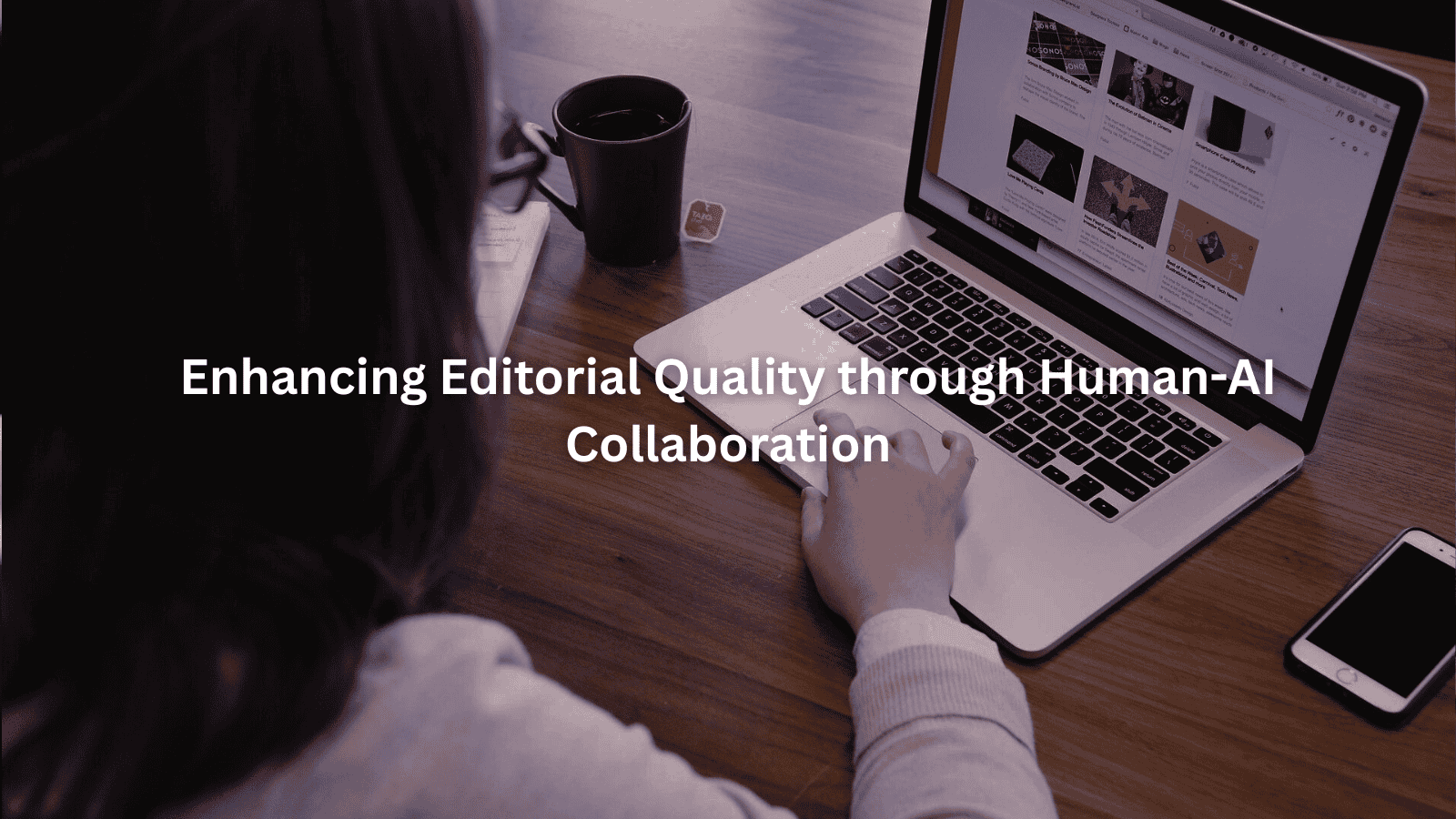
Our editors and AI make a pretty good team. We see it working every single day. Sure, computers can do some things faster than humans. But people know what people want to read. Simple as that.
At Jet Digital Pro, we’ve learned that integrating human-AI editors into the workflow creates the perfect balance between automation and authenticity, exactly what our content needs to stand out.
Getting the Mix Just Right
What AI Brings to the Table
Let’s be real. AI is fantastic at catching grammar stuff and those pesky typos. Saves us hours of work. And when it comes to SEO keywords and readability scores, the computer just crunches those numbers faster than any of us could. Makes sense.
Where Humans Step In
AI doesn’t get jokes, sarcasm, or subtle cultural references. Sometimes it suggests weird stuff. That’s why real editors keep an eye on things. They know when a sentence sounds off, even if it’s technically correct. And because companies want more than just average accuracy, especially in high-stakes areas, they need humans to catch what AI misses [ 2 ].
Ensuring Consistency and Brand Integrity
Editorial Tone and Voice Management
Maintaining a consistent editorial tone and voice is vital for brand integrity. AI can assist in suggesting tone adjustments, but we ensure that the final content aligns with our brand’s identity. We’ve found that this consistency builds trust with our audience.
Maintaining Content Accuracy and Compliance
Moreover, human editors play an essential role in ensuring content accuracy and compliance with legal or ethical standards. AI can help with initial checks, but our expertise is necessary for high-stakes content. This diligence safeguards our reputation and ensures that we uphold our commitment to quality.
Workflow Automation Benefits
Task Automation and Productivity Gains
One of the most significant advantages of integrating AI into our workflow is the automation of repetitive tasks. AI handles administrative duties like assigning work and scheduling, freeing up our time for more creative endeavors. This boost in productivity allows us to focus on what we do best, creating compelling content.
Data-Driven Content Insights and Trend Analysis
Additionally, AI tools provide valuable insights into content performance, helping us analyze trends and make informed decisions for future projects. This data-driven approach enhances our strategic planning and ensures that we remain ahead of industry trends.
Efficient Team Collaboration Tools
Real-Time Editing and Version Control
Collaboration tools play a crucial role in our workflow. We use real-time editing platforms that allow multiple team members to work on content simultaneously. This capability enhances our efficiency and ensures that everyone stays on the same page.
Centralized Workspaces and Standardization
We also utilize centralized workspaces to standardize our processes. By having shared templates and prompt libraries, we streamline our workflow and maintain consistency across projects. This organization is essential for scaling our operations effectively.
Best Practices for Optimizing Human-AI Editorial Workflows

Over the years, we’ve learned that optimizing our human-AI editorial workflows requires a combination of clear roles, continuous improvement, and a commitment to quality. We’ve trained our teams to get the most out of AI by using AI editors effectively, giving them clear instructions and refining prompts over time.
Defining Clear Roles and Boundaries
Task Division between AI and Human Editors
One of the first steps in optimizing our workflow is defining clear roles for both AI and human editors. We establish which tasks the AI will handle and which require human intervention. This clarity prevents overlap and ensures that each party operates within its strengths.
Training Teams to Coach AI Effectively
Training is also critical. We invest time in educating our teams on how to effectively coach AI for better outputs. This ongoing training ensures that our AI tools evolve alongside our editorial standards.
Establishing Feedback Loops and Continuous Improvement
Refining AI Prompts Based on Editorial Feedback
Creating feedback loops is essential for continuous improvement. By refining AI prompts based on our editorial feedback, we enable the AI to learn and improve over time. This iterative process enhances the quality of the outputs we receive.
Updating Workflow Playbooks and Standards
We also make it a point to regularly update our workflow playbooks and standards. This documentation helps us maintain a high level of quality and ensures that everyone is aligned on best practices.
Centralizing Processes and Resource Management
Use of Shared Prompt Libraries and Templates
Centralizing our processes has proven beneficial. We maintain shared prompt libraries and templates that streamline our workflow. This standardization not only saves time but also enhances the consistency of our content.
Workflow Automation for Task Scheduling and Monitoring
We also leverage workflow automation for task scheduling and monitoring. These tools help us keep track of progress and ensure that deadlines are met without compromising quality.
Quality Control and Final Review Protocols
Multi-Stage Editing and Approval Checkpoints
Quality control is a non-negotiable aspect of our workflow. We implement multi-stage editing and approval checkpoints to catch any errors before publication. This thorough review process is critical for maintaining our standards.
Documentation of Editorial Decisions and Outcomes
Finally, we document our editorial decisions and outcomes. This record-keeping not only helps us refine our processes but also serves as a valuable resource for future projects.
Advanced Techniques and Emerging Trends in Human-AI Editing
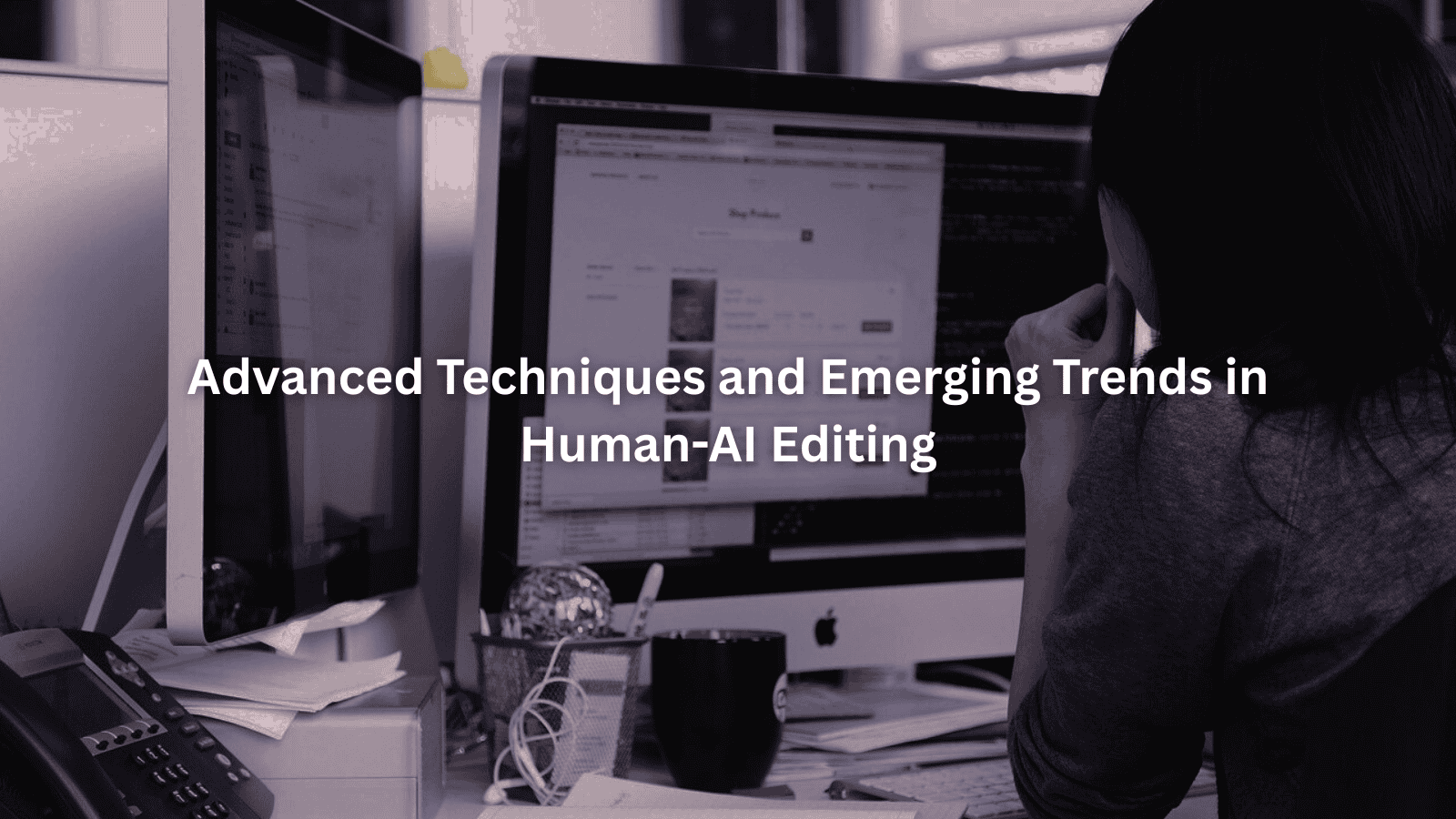
As we continue to evolve our workflows, we’re always on the lookout for advanced techniques and emerging trends that can further enhance our processes.
AI-Assisted Content Polishing and Refinement
Automated Repetitive Language Removal and Tone Adjustment
AI-assisted content polishing is one area where we see significant benefits. The technology can automatically remove repetitive language and suggest tone adjustments, saving us time and enhancing readability. This capability allows us to focus on more creative aspects of editing.
Are You a Digital Agency?
White Label SEO Content Services for Agencies
Scalable, customizable, and results-driven content solutions for your clients.
Correction of AI Hallucinations and Errors
Another critical function is the correction of AI hallucinations and errors. While AI can be a powerful tool, it’s not infallible. Our human editors are essential for identifying and correcting these mistakes, ensuring that the final content is accurate and reliable.
Enhancing Readability and Narrative Flow
Content Structure Review and Narrative Improvement
Improving content structure and narrative flow is a key goal. Here’s how the team approaches this:
- Prioritizing Readability: Enhancing readability is essential for engaging the audience.
- Reviewing Content Structure: Regularly assessing the content allows for pinpointing areas that need improvement.
- Engaging the Audience: Ensuring that the narrative captures attention is a top priority.
- Highlighting Human Creativity: This editing process showcases the team’s unique creative insights.
By focusing on these aspects, the team can create content that not only informs but also resonates with readers. It’s this blend of careful review and imaginative input that keeps the narrative dynamic and appealing, ensuring that every piece of content serves its purpose effectively.
Integration of Human Creativity in Final Edits
Finally, we make it a point to integrate our creativity into the final edits. AI may provide a solid foundation, but it’s our unique insights and perspectives that elevate the content to its highest potential.
Leveraging AI for Content Fact Verification
AI Support for Multistage Fact-Checking Processes
Fact verification is crucial, especially for high-stakes content. We leverage AI to support our multistage fact-checking processes. This technology helps us quickly identify potential inaccuracies, which we then validate through human oversight.
Human Verification for High-Stakes Accuracy
For content that carries significant weight, human verification is a must. We ensure that our most critical pieces undergo thorough checks by our experienced editors, maintaining the highest standards of accuracy.
Future Directions in Editorial Workflow Automation
Expanding AI Roles in Workflow Management
The future holds promise for expanding AI’s role in workflow management, a shift that could redefine processes. Here are key points to consider:
- Potential for Expansion: There’s clear potential for AI’s role to grow.
- Technological Evolution: As technology evolves, the integration of AI tools into processes will likely deepen.
- Productivity and Efficiency Boosts: These advancements are expected to enhance both productivity and efficiency.
By embracing these changes, organizations can leverage AI to streamline operations and create a more effective workflow. The ongoing evolution suggests exciting times ahead for teams ready to adapt and integrate these tools into their routines. This might just be the edge needed in a competitive landscape.
Evolving Human-AI Task Division Strategies
Finally, we recognize the need to continually evolve our strategies for task division between AI and human editors. As our understanding of AI capabilities grows, so too will our approach to leveraging these tools effectively.
Incorporating a human-AI editorial workflow has transformed our content creation process at Jet Digital Pro. By harnessing the strengths of both AI and human editors, we produce high-quality content that meets the demands of today’s digital landscape.
Need a Strategic SEO Content Partner?
Let’s craft SEO content that ranks, converts, and grows your brand.
Talk to UsThis integration not only enhances our productivity but also ensures that we maintain the creative spark that sets our work apart. As we continue to refine our workflows and embrace new technologies, we’re excited about the possibilities ahead.
FAQ
How does AI assist in the drafting process while ensuring quality control?
AI plays a crucial role in the drafting process by generating initial outlines and full drafts based on predefined prompts. However, quality control remains in human hands.
After the AI provides its output, human editors review and refine the content for clarity and logic. This two-step approach helps leverage AI’s speed while ensuring that the final product meets our quality standards and resonates with our audience.
What specific tools do we use to integrate AI into our editorial workflow?
We utilize various AI tools that focus on different aspects of the editorial process. For drafting, we might use AI writing assistants that generate content based on our prompts. For editing, tools that check grammar, style, and SEO help streamline revisions.
Additionally, collaboration platforms allow real-time editing and version control, enabling both AI and human inputs to flow seamlessly throughout our workflow.
How do we ensure that the content produced by AI aligns with our brand’s voice and tone?
To maintain brand consistency, we create detailed creative briefs that outline our voice and tone guidelines. These documents serve as a foundation for both AI-generated content and human editing.
During the editing phase, human editors focus on adjusting the tone to fit our brand’s identity, ensuring that the content remains authentic and engaging. This process emphasizes the value of human oversight in achieving a cohesive presentation.
What challenges do we face when integrating AI into our editorial workflow, and how do we address them?
Integrating AI into our workflow comes with challenges, such as ensuring that the AI understands our specific needs and adapting to its limitations. AI can produce content that lacks nuance or context, which is where human editors become vital.
We address these challenges by continuously refining our AI prompts and providing feedback to improve its outputs. This iterative process helps us bridge the gap between AI capabilities and our editorial standards.
How does our collaborative workflow improve team communication and streamline processes?
Our collaborative workflow fosters open communication and teamwork among all members. By using shared platforms for real-time editing and feedback, we ensure that everyone stays informed and aligned.
This transparency reduces misunderstandings and speeds up the editing process, as team members can comment and suggest changes directly on the document. As a result, our workflow becomes more efficient, allowing us to produce high-quality content in a timely manner.
Conclusion
Embracing a human-AI editorial workflow has transformed our approach at Jet Digital Pro. By blending AI efficiency with human expertise, we deliver scalable, high-quality content that meets today’s SEO demands without sacrificing authenticity.
This synergy helps digital agencies expand their offerings while keeping internal workloads low. As we refine our process, our commitment to brand integrity and measurable results remains strong.
Ready to scale your content with ease? Let’s talk.
References
- https://www.nature.com/articles/s41598-024-69423-
- https://fortune.com/2025/07/08/companies-want-ai-to-be-better-than-the-average-human-measuring-that-isnt-straightforward
Related Articles
- https://jetdigitalpro.com/integrating-human-ai-editors-into-workflow/
- https://jetdigitalpro.com/collaborating-with-a-human-ai-editor
- https://jetdigitalpro.com/how-to-use-human-ai-editor
P.S – Whenever you’re ready,
we’re here to help elevate your SEO content.
Partner with us for strategic, scalable content that drives real organic growth.
Contact Us Now
